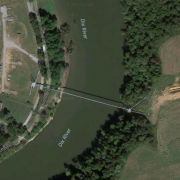Groundwater Pumping Sinks Beijing Region at Increasing Rate
Satellite data reveal the depths of the megacity’s thirst.

A community in Hebei Province, just outside of Beijing, drills for water to replace a dry well. The proliferation of such wells in the Beijing region is causing the land to sink, a process called subsidence. Photo © Aaron Jaffe / Circle of Blue
By Brett Walton, Circle of Blue
Beijing, one of the world’s most water-scarce large cities, has long drawn on groundwater reserves to supply more than 20 million people. The unrelenting pressure for water, though, is causing the land to shift and sink and buckle, which puts subway and high-speed rail lines, buildings, and other infrastructure at risk of damage.
If the region’s water-related land shifts, technically known as “subsidence,” go unchecked, severe consequences could be in store. Scientists at a railway engineering laboratory at Beijing Jiaotang University concluded in a September 2015 study that groundwater pumping must be restricted near completed high-speed rail lines and that new wells near the lines should be prohibited.
The trains, which reach speeds of more than 300 kilometers (186 miles) per hour, require stable tracks to keep the cars from derailing. The high-speed lines from Beijing to Shanghai and Beijing to Tianjin, a heavily populated port city, both pass through the Chaoyang subsidence zone east of Beijing. The researchers said that continued subsidence will have a “strong impact on the safety of train operation.”
According to satellite measurements, the Beijing region is sinking at an increasing rate as the soil of the North China Plain, like a sponge wrung dry, compacts around depleted aquifers. The data were published earlier this month in the journal Remote Sensing.
A common symptom of voracious groundwater use, subsidence is taking a toll on the world’s largest urban areas. More than 50 Chinese cities are grappling with uneven soils. In Southeast Asia, Bangkok, Ho Chi Minh City, and Manila are all sinking. Parts of Jakarta, the Indonesian capital, are dropping as rapidly as Beijing’s Chaoyang district.
Subsidence is a problem in the Americas, too. Mexico City is infamous for fractured building foundations that are a hallmark of sagging land. The industrial corridor along the Mississippi River Delta outside New Orleans is settling, increasing the flood risk, according to a NASA analysis published last month. In California’s Central Valley, where aquifer levels dropped to record lows recently because of drought-induced pumping, bridges and canals are cracking under the strain of subsiding soil.
Beijing’s Unstable Ground
Subsidence is “relatively minor” in Beijing’s center, averaging 10 millimeters (0.4 inches) per year between 2003 and 2011, according to researchers. But in Beijing’s eastern, outlying districts the problem is much worse. Parts of Changping, Shunyi, and Tongzhou experienced subsidence rates that were six to eight times higher. The deepest depression is in Chaoyang, where the maximum rate reached 110 millimeters (4.3 inches) per year.
Subsidence was first documented in the Beijing region in 1935, and numerous studies since then have connected the collapsing land to a rise in groundwater pumping. As much as two-thirds of the region’s water supply comes from groundwater. The Remote Sensing study used InSAR, which is a type of radar that monitors land elevation changes, and well data to look more closely at the geological factors that result in different rates of decline.
A number of factors are at play, including tectonic fault lines, soil types, and the location of groundwater wells. The researchers found that subsidence increases closer to wells and it increases in clay soils, which are finer-grained and thus more compactable — more like Play-Doh than beach sand.
Aquifers with larger soil particles tend to be more “elastic,” meaning that subsidence can be partially reversed when more water is stored. The researchers found such an example in one of the observation wells they used to check the satellite data. The vast majority of wells, however, were not elastic. The ground is permanently altered and the water-storing capacity of the aquifer is forever diminished.
Roberto Tomas, a study co-author and an engineering professor at the University of Alicante, in Spain, told Circle of Blue that a high rate of subsidence does not necessarily cause the most damage. What is important, he said is uneven subsidence.
“If part of a building settles and the other part is stable or presents a lower settlement, then the building suffers a distortion that causes internal stresses that can damage it,” he explained.
Tomas said that his research group is now conducting an analysis of how subsidence in the Beijing region is affecting critical infrastructure. That paper should be published by the end of the year, he said.
Brett writes about agriculture, energy, infrastructure, and the politics and economics of water in the United States. He also writes the Federal Water Tap, Circle of Blue’s weekly digest of U.S. government water news. He is the winner of two Society of Environmental Journalists reporting awards, one of the top honors in American environmental journalism: first place for explanatory reporting for a series on septic system pollution in the United States(2016) and third place for beat reporting in a small market (2014). He received the Sierra Club’s Distinguished Service Award in 2018. Brett lives in Seattle, where he hikes the mountains and bakes pies. Contact Brett Walton










